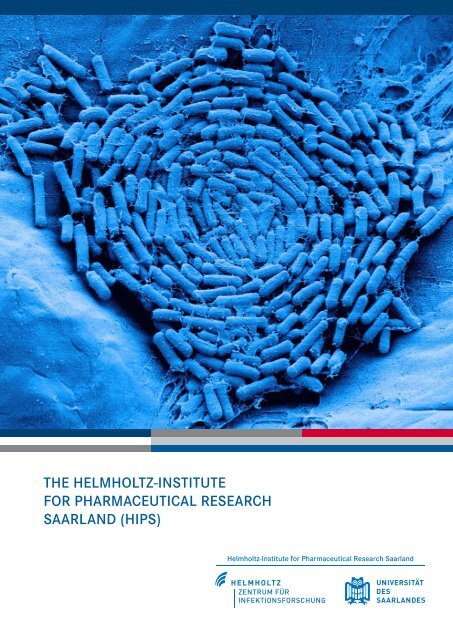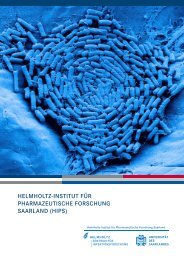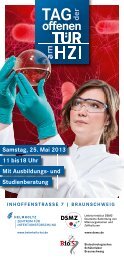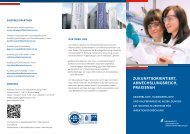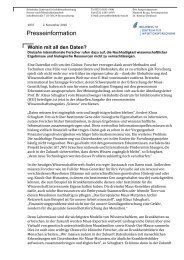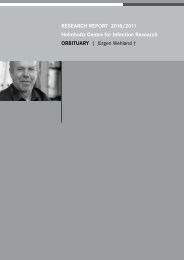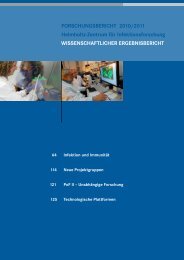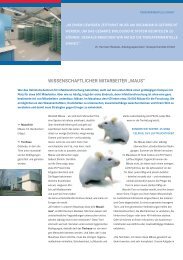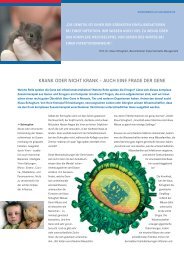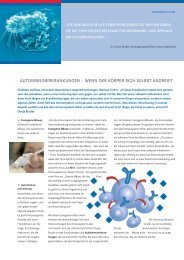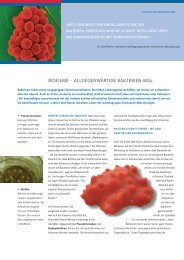hIPs - Helmholtz-Zentrum für Infektionsforschung
hIPs - Helmholtz-Zentrum für Infektionsforschung
hIPs - Helmholtz-Zentrum für Infektionsforschung
Create successful ePaper yourself
Turn your PDF publications into a flip-book with our unique Google optimized e-Paper software.
Deutsch:<br />
<strong>Helmholtz</strong>-Institut <strong>für</strong> Pharmazeutische Forschung Saarland<br />
The <strong>Helmholtz</strong>-Institute<br />
for Pharmaceutical Research<br />
Saarland (HIPS)<br />
Englisch:<br />
<strong>Helmholtz</strong>-Institute for Pharmaceutical Research Saarland
Foreword<br />
3<br />
The <strong>Helmholtz</strong> Centre for Infection Research (HZI) in Braunschweig and its institutes at their various locations are some of<br />
the most outstanding research facilities in Germany. Their renowned scientists are engaged in health research and develop<br />
new pharmaceutical drugs and therapies against dangerous infectious diseases.<br />
The antibiotic resistance of dangerous bacteria results in hospitals facing major challenges especially when performing vital<br />
surgery. The <strong>Helmholtz</strong>-Institute for Pharmaceutical Research Saarland (HIPS) is taking up the challenge of discovering new<br />
active agents against resistant microbes. The Institute was founded in August 2009 by the <strong>Helmholtz</strong> Centre for Infection<br />
Research in Braunschweig and Saarland University with the goal of developing novel pharmaceuticals against dangerous<br />
and frequently life-threatening infectious diseases. The research pursued at the <strong>Helmholtz</strong> Centre is tremendously<br />
successful. Many people all over the world benefit from new, innovative methods of treatment for infectious diseases that<br />
are triggered by bacteria, viruses and other pathogens.<br />
With the successes achieved to date, the Institute fits perfectly into the innovation strategy of the Saarland, which focuses<br />
on close-to-the-market research. Research, development and science are crucial vehicles for the further development of<br />
the Saarland as a business location.<br />
I am delighted about the positive development of the HIPS, which has established itself as an internationally recognized,<br />
leading research facility within a very short time, and I hope that in the future the Institute and the renowned scientists<br />
working there will succeed in making even more groundbreaking discoveries within the field of health research.<br />
Annegret Kramp-Karrenbauer<br />
State Prime Minister of Saarland
4<br />
The <strong>Helmholtz</strong>-Institute for Pharmaceutical<br />
Research Saarland (HIPS)<br />
Increasing (multi)-resistance towards established antibiotics is a serious medical problem. Re-emerging and new<br />
infectious diseases are of equal concern. In addition, the development of new drugs against such illnesses is<br />
currently based mainly on known mechanisms of action and old molecule scaffolds, which allows bacteria to<br />
develop and spread resistance rapidly. There is thus an urgent need for new strategies aimed at the discovery and<br />
development of novel anti-infective pharmaceuticals: This is the research focus of the <strong>Helmholtz</strong>-Institute for<br />
Pharmaceutical Research Saarland (HIPS).<br />
Antibiotics have been used successfully for the last 70 years.<br />
Since their introduction the mortality rate from infectious<br />
diseases has fallen dramatically. However, these drugs have<br />
been applied so widely and for so long that the infectious<br />
organisms have adapted to them, making these drugs less<br />
effective. Once restricted almost exclusively to developing<br />
countries, resistant pathogens are now spreading in hospitals<br />
and in communities in developed countries as well. Research<br />
to develop novel antimicrobial drugs is required – and this is<br />
precisely the issue that is being tackled by the <strong>Helmholtz</strong>-<br />
Institute for Pharmaceutical Research Saarland (HIPS).<br />
The Institute was founded in 2009 in Saarbrücken,<br />
Germany, following a positive international evaluation<br />
of a joint proposal from the <strong>Helmholtz</strong> Centre for Infection<br />
Research (HZI) and Saarland University (UdS). The HIPS is<br />
the first non-university based research facility in Germany<br />
that is explicitly devoted to pharmaceutical research, and it<br />
is closely integrated into UdS on the basis of a cooperation<br />
agreement between the HZI and UdS. As a branch of the<br />
HZI, the HIPS is involved in the activities of the “Health”<br />
research field of the <strong>Helmholtz</strong> Association and the<br />
“Infection and Immunity” research program.
5<br />
eXpertise On infectiOus diseases and<br />
pharmaceutical research<br />
The range of scientific work at the HIPS comprises genetic<br />
and genome-based methods for optimizing natural product<br />
producers and lead compounds as well as methodologies<br />
to improve the transport of pharmaceutical agents to their<br />
target. The combination of the HZI’s knowledge of infectious<br />
diseases and the HIPS’ pharmaceutical research puts the<br />
HIPS in a unique position both in Germany and in Europe,<br />
especially regarding the development of anti-infectives.<br />
This complementary expertise allows concerted and<br />
synchronous approaches towards the discovery and<br />
mining of novel producers for potential drugs, their rational<br />
improvement and bioprofiling, as well as their optimal<br />
formulation. This combination of expertise greatly enhances<br />
the probability of identifying and utilizing novel natural<br />
products, and accelerates their advancement to<br />
(pre)clinical studies. The combined research activities<br />
and experience of scientists at the HIPS, the HZI and<br />
further regional and international cooperations in drug<br />
development make it possible to cover drug development<br />
in its entirety from early drug discovery to clinical phase<br />
studies. A successful implementation of translational<br />
research is thus achieved.<br />
departments at the hips<br />
JuniOr research grOups
<strong>hIPs</strong><br />
Discovery of novel natural products and engineering<br />
of their biotechnological production<br />
Natural product diversification through<br />
metabolic engineering<br />
Rational drug design to optimize<br />
pharmaceutical properties<br />
Exploiting chemical biology of carbohydrates<br />
for drug design<br />
Designing (nano)carrier systems and developing<br />
cell- and tissue based in vitro models<br />
6<br />
saarland university<br />
novel<br />
anti-Infectives<br />
helmholtz centre<br />
for Infection research<br />
external Partners<br />
hips events tO eXchange ideas<br />
The HIPS regularly organizes events which bring together<br />
renowned scientists and young investigators from three<br />
pharmaceutical communities: Natural products, medicinal<br />
chemistry and drug delivery. The HIPS Symposium provides a<br />
forum for senior scientists to exchange ideas while crossing<br />
the boundaries of classical disciplines. At the same time it<br />
gives young investigators the opportunity to obtain valuable<br />
feedback on their projects from international experts in<br />
the respective fields. The plan is to establish the HIPS<br />
Symposium as a creative meeting with a regular place in the<br />
schedule of leading scientists from these research fields in<br />
Europe and beyond. The HIPS Talk invites scientists from<br />
different disciplines who are interested in pharmaceutical<br />
research from faculties and public research institutes to the<br />
Saarland University campus. Other events, like workshops,<br />
are an additional part of the creative development process.<br />
HIPS Symposium
Draft © ARCHITEKTEN BDA RDS PARTNER<br />
The HIPS originates from three pharmaceutical research<br />
departments of Saarland University headed by Professors<br />
Rolf Müller (Managing Director of the HIPS and former<br />
scientist at the HZI), Rolf W. Hartmann and Claus-Michael<br />
Lehr. Rolf Müller’s research focuses on the exploitation<br />
of microbial agents, primarily from myxobacteria (MINS<br />
Department, Microbial Natural Products), Rolf Hartmann’s<br />
Department specializes in pharmaceutical and medicinal<br />
chemistry (DDOP Department; Drug Design and<br />
Optimization) while Claus-Michael Lehr investigates the<br />
targeted transport of drugs to the source of disease<br />
(DDEL Department; Drug Delivery).<br />
From 2009 to presumably 2014 (by when it is expected<br />
new appointments will have been made to the chairs of<br />
pharmacy at UdS), the three professors hold chairs of<br />
European Union<br />
European Regional Development Fund<br />
Investing in Your Future<br />
pharmacy at UdS and are also department heads at the<br />
HIPS, so that their research groups originate from both<br />
UdS and the HIPS. Currently, two junior research groups<br />
are located at the HIPS: The AMEG group headed by Andriy<br />
Luzhetskyy specializes in the engineering of actinobacteria,<br />
while Alexander Titz’s research focuses on the Chemical<br />
Biology of Carbohydrates (CBCH).<br />
In 2015 the new HIPS building on the UdS campus will<br />
be completed, and all HIPS departments, junior research<br />
groups and infrastructures can then be accommodated<br />
under one roof.<br />
7<br />
The HIPS is funded by the German Federal Government and the Federal State of the Saarland<br />
and has an annual budget of 5.5 million euros. Since the foundation of the HIPS the <strong>Helmholtz</strong><br />
Association has also been represented in the Saarland. As Germany`s largest scientific research<br />
organization the <strong>Helmholtz</strong> Association contributes to solving the grand challenges of society,<br />
science and industry by performing cutting edge research in the fields of Energy, Earth and<br />
Environment, Health, Key Technologies, Structure of Matter, Aeronautics, Space and Transport. The<br />
Association has an annual budget of 3.8 billion euros and almost 34 000 collaborators undertake<br />
research into systems of great complexity with large-scale facilities and scientific infrastructure,<br />
cooperating closely with national and international partners.<br />
See also: www.helmholtz.de/en/partners.
mins<br />
8<br />
The deParTmenT “mIcroBIal naTural ProducTs”<br />
Natural products of microbial origin continue to be very<br />
promising sources for the development of pharmaceuticals.<br />
Compared to synthetic compounds, natural products cover<br />
a unique chemical space and they are also thought to<br />
be evolutionarily optimized binders for various biological<br />
targets. They can exhibit diverse biological activities<br />
and modes-of-action, making them useful for numerous<br />
therapeutic applications like the treatment of infections<br />
or cancer. However, finding and developing new bioactive<br />
compounds, so-called secondary metabolites, from<br />
microorganisms is a challenging task. The overall success<br />
depends on good sources (proficient microbial producer<br />
strains) as well as the professional interplay of<br />
various interdisciplinary approaches.<br />
The research in the “Microbial<br />
Natural Products” Department<br />
aims to exploit the rich<br />
biosynthetic potential<br />
of microorganisms,<br />
especially soil-dwelling<br />
myxobacteria, for the<br />
production of novel<br />
natural products.<br />
discOverY Of nOvel<br />
biOactive cOmpOunds<br />
An on-going, world-wide strain discovery program, in close<br />
collaboration with the “Microbial Drugs” Department at the<br />
HZI in Braunschweig, aims to identify new myxobacterial<br />
species, genera and families. Once new isolates have<br />
been successfully adapted to growth under laboratory<br />
conditions, cultivations are performed and culture extracts<br />
are then screened for promising bioactivities mainly<br />
against human pathogens. The discovery of novel natural<br />
products is underpinned by state-of-the art analytical<br />
techniques, which allow an in-depth analysis of the<br />
strain`s secondary metabolite profiles.<br />
The scientists also decipher the<br />
genetic information of the bacteria<br />
to obtain comprehensive<br />
insights into their metabolic<br />
capabilities. As many natural<br />
product biosynthesis<br />
pathways are not active<br />
and considered to be<br />
‘silent’ under standard<br />
cultivation conditions,<br />
several tricks are applied<br />
to activate these pathways<br />
Map of the circular Sorangium<br />
cellulosum So ce56 genome
9<br />
and to ‘mine’ the genomes for all potential secondary<br />
metabolites. New compounds are isolated from culture<br />
extracts using a range of available separation techniques,<br />
and when necessary production scale-up is accomplished<br />
by fermentation on the 100 liter scale to isolate enough<br />
material for structure elucidation and further biological<br />
studies.<br />
Optimization of biotechnological<br />
production<br />
Following the discovery of new natural products exhibiting<br />
promising activity, different strategies are applied to<br />
improve both their production yields and their structures,<br />
e.g. to optimize their pharmaceutical and pharmacological<br />
properties. To this end, an in-depth investigation of the<br />
underlying biosynthetic mechanisms and regulatory<br />
networks controlling production is performed. Based<br />
on these results rational production engineering is carried<br />
out by genetic manipulation of the producer strains or<br />
by transferring complete natural product biosynthetic<br />
pathways into suitable host strains for heterologous<br />
production. Overall, these synthetic biotechnology<br />
endeavors aim at translating early natural product hits<br />
into clinical application.<br />
Rolf Müller´s group provides a highly interdisciplinary<br />
research environment, where a broad spectrum of<br />
techniques, including microbiological, molecular-biological,<br />
genetic, biochemical, analytical and bioengineering<br />
methods, are combined to exploit microbial natural<br />
products for drug discovery and development approaches.<br />
Molecular structure of Argyrin,<br />
a metabolite from myxobacteria<br />
showing antibacterial activity<br />
Chondromyces crocatus fruiting body,<br />
containing large numbers of myxospores<br />
High-resolution mass spectrometry<br />
platform for the in-depth analysis of<br />
secondary metabolomes
ddOp<br />
10<br />
The “druG desIGn and<br />
oPTImIzaTIon” deParTmenT<br />
Recent advances in microbiology have resulted in the<br />
identification of an increasing number of natural products<br />
which exhibit antibiotic activity. However, most of these<br />
structures are not suitable to be used as drugs due to<br />
their unfavorable pharmacokinetic properties, such as<br />
poor solubility or difficult large-scale synthesis. The<br />
Department of “Drug Design and Optimization” focuses<br />
on the development of novel synthetic antibiotics, which<br />
can either be derivatives of natural products with<br />
improved druglikeness or synthetic compounds<br />
based on a rational drug design. Diverse strategies<br />
of medicinal chemistry are applied. Currently,<br />
the Department is working on two projects: The<br />
synthesis of antibiotic compounds targeting<br />
either the bacterial growth or the cell-to-cell<br />
communication.<br />
PPI<br />
switch region<br />
improved solubility<br />
improved activity<br />
Rational development of antivirulence compounds with improved physicochemical<br />
properties<br />
Structure of E. coli RNA polymerase. Inhibitors can be designed to target<br />
e. g. protein-protein interactions (PPI); defined binding sites can be used<br />
to develop a pharmacophore (ph4) model.
©HZI/Bellhäuser<br />
11<br />
Novel RNAP inhibitors stop bacterial growth<br />
The bacterial RNA polymerase (RNAP) is essential for<br />
bacterial growth and is well conserved between different<br />
bacteria.<br />
antibacterial activity, DDOP aims to elucidate the mode<br />
of action and to optimize the pharmacokinetic properties<br />
of novel compounds. These endeavors should lead to new<br />
and highly potent antibiotics to be used in therapeutic<br />
applications in humans.<br />
However, marketed RNAP inhibitors have evoked resistant<br />
strains by point-mutations in their binding sites. Rolf<br />
Hartmann´s group aims to develop bacterial RNAP<br />
inhibitors with novel modes of action. It applies different<br />
methods such as ELISA- and SPR-based experiments<br />
as well as classical enzyme inhibition assays. The group<br />
utilizes computer-aided drug design (CADD) strategies to<br />
understand RNAP inhibition and to spark new ideas for<br />
drug design. Besides improving the RNAP inhibitory and<br />
Interfering WITH cell-to-cell<br />
communication in bacteria<br />
In a second project, the scientists of the DDOP Department<br />
develop compounds that interfere with the cell-to-cell<br />
communication in the bacterium Pseudomonas aeruginosa.<br />
Lung infections caused by this pathogen are difficult to<br />
treat when bacteria arrange themselves into clusters, so<br />
called biofilms. These dense layers suppress the uptake<br />
of antibiotics. The formation of biofilms and also the<br />
production of virulence factors are controlled by cell-tocell<br />
communication systems (quorum sensing) in response<br />
to signal molecules. Pseudomonas aeruginosa has a third<br />
unique communication system which is regulated by PQS<br />
(Pseudomonas Quinoline Signal) as a signaling molecule.<br />
The DDOP Department aims to develop compounds that<br />
interfere with the PQS-dependent signaling in order to<br />
prevent the formation of biofilms and the production of<br />
virulence factors, without affecting the microbial viability.<br />
Chemical synthesis of small molecule antibacterial agents
ddel<br />
12<br />
The deParTmenT “druG delIverY”<br />
Advances in molecular biotechnology and medicinal<br />
chemistry have led to the discovery of new drug<br />
candidates. However, developing these molecules into<br />
actual pharmaceuticals first requires the screening of their<br />
biochemical properties and their ability to cross biological<br />
barriers.<br />
Scientists must establish new technologies to ensure the<br />
safe and effective delivery of the drug candidate to the site<br />
of action, for example the site of infection or components<br />
of the immune system. Therefore, the main focus of the<br />
“Drug Delivery” Department is on the exploration of the<br />
biological barriers themselves, which are present between<br />
the sites of drug administration and drug action.<br />
disease-relevant mOdels withOut<br />
animal eXperiments<br />
An important line of the research focuses on laboratory cell<br />
culture models to study the epithelial barriers of the lungs,<br />
the gastro-intestinal tract, and the skin under controlled<br />
conditions in vitro. The establishment of disease-relevant in<br />
vitro models for infections and/or inflammation of the<br />
respective barriers allows the therapeutic efficacy of<br />
novel drug candidates to be demonstrated via adequate<br />
biomarkers without using animal experiments. Such<br />
models make it possible to perform pre-screening or<br />
high throughput screenings of drug candidates as well as<br />
a detailed investigation of transport mechanisms in an<br />
environment which is less complex than the in vivo situation<br />
– the situation in living organisms. Similarly, such models<br />
also have considerable potential as alternatives to animal<br />
testing in the drug development process.<br />
The Department headed by Claus-Michael Lehr has<br />
developed an in vitro co-culture model for inflamed<br />
intestinal mucosa. The model, honored by two animal<br />
welfare awards from the German Federal Ministry of Food,<br />
Agriculture and Consumer Protection (BMELV) and the<br />
State of Rhineland-Palatinate, has been successfully applied<br />
to the testing of first anti-inflammatory formulations. In<br />
collaboration with other groups at the HZI, this in vitro<br />
model will be applied to identify epithelial inflammation<br />
markers and to study mechanisms of bacterial adhesion<br />
and invasion of enteropathogens. Understanding and<br />
mimicking the bacterial invasion pathway will allow even<br />
more effective targeting of diseased areas and increased<br />
cellular internalization of drug carriers, by using invasion<br />
decorated particles, for example. Furthermore, other<br />
complex, disease-relevant in vitro models are being studied<br />
by developing both a co-culture model of the blood-airbarrier<br />
and a pulmonary biofilm model.
13<br />
carrier sYstems crOssing<br />
biOlOgical barriers<br />
A second major research line of the “Drug Delivery”<br />
Department consists of developing appropriate carrier<br />
systems that are capable of crossing biological barriers<br />
and thereby improving the delivery of the active molecule<br />
to the target. This is particularly relevant in the context<br />
of macromolecular biopharmaceuticals such as peptides,<br />
proteins, and RNA or DNA based drugs. In parallel, the<br />
nanotechnology platform, part of the Department, is<br />
to be advanced and broadened in terms of formulating<br />
multifunctional nanocarriers that allow tracking of the<br />
carriers, targeting to the site of action and release of<br />
the payload in a controllable manner both in vitro and<br />
in vivo. Last but not least, the carrier systems must be<br />
safely eliminated from the body, preferably by biological<br />
degradation of their constituents. Taken together, DDEL<br />
researchers are interested in a deeper understanding of<br />
the function of biological barriers in the healthy and the<br />
diseased state as well as in their interaction with (nano)<br />
particulate drug carriers.<br />
Developing carrier systems<br />
that are capable of crossing<br />
biological barriers<br />
Intestinal epithelial cell<br />
Dendritic cell<br />
Filter membrane<br />
Pro-inflammatory compound<br />
Apical compartment<br />
Macrophage<br />
Collagen layer<br />
Basolateral compartment<br />
Experimental set-up of the co-culture consisting intestinal epithelial cell line, macrophages and dendritic cells<br />
Experimental set-up of the co-culture consisting of an<br />
intestinal epithelial cell line, macrophages and dendritic cells
ameg<br />
14<br />
JunIor research GrouP:<br />
“naTural ProducT dIscoverY BY<br />
acTInoBacTerIa meTaBolIc enGIneerInG”<br />
Actinomycetes are a well-known and very intensively<br />
investigated group of bacteria. They have produced various<br />
antitumor drugs and are used industrially to produce<br />
antibiotics. Despite their track record in antibiotic<br />
production, a huge potential still remains to be revealed:<br />
Actinomycetes have about 30 biosynthetic gene clusters<br />
which are responsible for natural product biosynthesis - the<br />
function of most of them is still unknown. Whole complexes<br />
of genes are not active under normal laboratory conditions.<br />
In most cases it is not yet known how these “silent genes”<br />
are switched on and which substances they produce in an<br />
active state.<br />
The HIPS “Actinobacteria Metabolic Engineering” Junior<br />
Research Group activates such genes in the microbial<br />
genome: Powerful and efficient instruments for highthroughput<br />
genetic analysis of actinobacteria are provided<br />
by special enzymes like site-specific recombinases,<br />
transposases, I-SceI meganuclease and beta-glucuronidase<br />
based systems. Those recently developed genetic tools are<br />
being used for the construction of synthetic biobricks, the<br />
identification of regulatory networks, which are responsible<br />
for “silencing” natural products biosynthesis, and the<br />
generation of suitable hosts for the antibiotic production<br />
and activation of “cryptic” biosynthetic gene clusters.<br />
Andriy Luzhetskyy’s group anticipates that the methods will<br />
provide new possibilities for the study of functional gene<br />
expression in actinomycetes and eventually lead to natural<br />
product discovery.<br />
Different transposon mutants of<br />
Streptomyces coelicolor M145
cbch<br />
15<br />
JunIor research GrouP:<br />
“chemIcal BIoloGY of carBohYdraTes”<br />
Carbohydrates and glycoconjugates belong to the three<br />
major classes of biopolymers. Complex carbohydrates play<br />
important roles in biological recognition processes, which<br />
are represented by the presence of dense glycoconjugate<br />
layers on cells, known as the glycocalyx. Despite their<br />
importance, the study of carbohydrates suffers because<br />
of the limited methods available for their synthesis and<br />
analysis, a problem not experienced with the study of<br />
nucleic acids or proteins.<br />
treatment Of chrOnic infectiOns: disrupting<br />
lectin-mediated biOfilms<br />
Many human pathogens can establish chronic infections<br />
with the help of a biofilm mode of life. As a protective<br />
shield, the matrix of the biofilm renders antibiotics<br />
ineffective and ensures the survival of the embedded<br />
pathogen. Novel ways for treatment address the<br />
disintegration of such biofilms, and thus restore the<br />
activity of antibiotics. The architecture of biofilms is<br />
frequently maintained by carbohydrates and so-called<br />
lectins, which recognize and crosslink carbohydrate<br />
motifs of the glycocalyx, both on human cells and<br />
pathogens. The inhibition of such structural components<br />
leads to the disruption of a biofilm and thereby allows<br />
treatment of the infection. Pseudomonas aeruginosa is an<br />
important pathogen in hospital-acquired infections and<br />
for cystic fibrosis patients. This Gram-negative bacterium<br />
can establish chronic infections in various tissues by<br />
accumulating into protective biofilms. One focus of the<br />
research here is on two P. aeruginosa lectins, which are<br />
crucial elements of the biofilm architecture.<br />
The group headed by Alexander Titz aims to develop<br />
antibacterial drugs using a combination of medicinal<br />
chemistry, biochemistry and microbiological methods.<br />
Recently, a competitive binding assay was developed for<br />
the in vitro evaluation of inhibitors of the Pseudomonas<br />
lectins. In collaboration with other groups at the HIPS and<br />
the HZI, potent molecules obtained by the group are then<br />
evaluated further in biofilm and infection models. Such<br />
compounds may ultimately lead to the successful treatment<br />
of chronic infections without evoking resistance among the<br />
pathogens.
Interview<br />
Prof. Dr. Rolf Müller,<br />
Managing Director of the <strong>Helmholtz</strong>-Institute<br />
for Pharmaceutical Research Saarland (HIPS)<br />
and Head of the<br />
“Microbial Natural Products” Department<br />
16<br />
Rolf Müller studied pharmacy at Bonn University and obtained his PhD at the Department of Pharmaceutical<br />
Biology. In 1996, he went to the Department of Chemistry at the University of Washington in Seattle, USA. This<br />
was when he began to investigate the production of antibiotics in bacteria. Two years later he returned to Germany<br />
as a junior group leader at the German Research Centre for Biotechnology (GBF, now the HZI) in Braunschweig.<br />
In 2000, he completed his habilitation thesis at the Technische Universität Braunschweig on the biosynthesis of<br />
antibiotics in actinomycetes and myxobacteria. Since October 2003, Rolf Müller has held a chair as professor of<br />
Pharmaceutical Biotechnology at Saarland University. His research has already earned the Phoenix-Pharmacy<br />
Research Award twice, the DECHEMA Award for Natural Products Research, the BioFuture Award of the German<br />
Federal Ministry for Education and Research, and the DECHEMA Award of the Max-Buchner Research Foundation.<br />
Since 2012 he has been a member of the German National Academy of Science and Engineering.<br />
In 2009 Rolf Müller became the Director of the <strong>Helmholtz</strong>-Institute for Pharmaceutical Research Saarland (HIPS)<br />
and heads the Department of “Microbial Natural Products” (MINS).<br />
Professor Müller, the HIPS has set itself the goal of<br />
combining pharmaceutical research and research<br />
into infectious diseases, why is that important?<br />
The number of dangerous pathogens is increasing globally.<br />
But the problem is certainly not just limited to developing<br />
countries, as the increasing incidence of multidrugresistant<br />
tuberculosis clearly shows. Neither must the<br />
significance of infectious diseases here in Germany be<br />
underestimated. With more and more organisms developing<br />
resistances to available antibiotics, there are simply not<br />
enough new active agents currently under development.<br />
Our parent organization, the <strong>Helmholtz</strong> Centre for Infection<br />
Research (HZI) in Braunschweig, has extensive expertise in<br />
the field of infection research. However, until recently there<br />
was a lack of pharmaceutical know-how to drive forward<br />
the development of new drugs. The key motivation behind<br />
the creation of the HIPS was therefore to combine the skills<br />
and knowledge at the HZI and Saarland University so that<br />
both institutions could work together to develop new antiinfective<br />
strategies and agents.<br />
Why was the Saarland chosen as the location for the<br />
new Institute?<br />
Saarland University has an excellent reputation for<br />
pharmaceutical research, covering areas such as medicinal<br />
chemistry, pharmaceutical technology, pharmaceutical<br />
biology as well as pharmacology and toxicology. Much of<br />
the work involves natural products – and about 80 percent
scientific advisOrY bOard<br />
of anti-infectives currently in clinical use are based on<br />
natural products. Personal ties to the HZI certainly also<br />
played a role. I myself spent almost eight years at the HZI in<br />
Braunschweig before I took up an endowed professorship<br />
at Saarland University in the area of pharmaceutical<br />
biotechnology in 2003.<br />
the hips was established jointly by saarland<br />
university and the helmholtz centre for infection<br />
research. founding the new institute must have<br />
required close collaboration between braunschweig<br />
and saarbrücken.<br />
Yes, that’s right, but despite their relatively large<br />
geographical separation, collaboration was excellent right<br />
from the start. And I’d like to take this opportunity to thank<br />
all those involved at the HZI, particularly the late Jürgen<br />
Wehland, and at Saarland University. The state government<br />
here in the Saarland has also given us outstanding support,<br />
for example by providing the funding for the new HIPS<br />
building. We are very pleased to see that establishing<br />
Saarbrücken as a major centre of pharmaceutical research<br />
has received such strong political backing. It is also nice to<br />
see that the work we do is now getting positive feedback<br />
from a very broad political base at both the regional and<br />
national levels.<br />
regular events such as the hips symposium and the<br />
hips talks are also helping to raise public awareness<br />
of the hips and what it does.<br />
The HIPS Talks are well attended and we’ve been able<br />
to invite some very distinguished speakers. The HIPS<br />
Symposium is generally held at the same time as the<br />
meeting of our Scientific Advisory Board (SAB). The SAB<br />
is made up of world renowned scientists, who also make<br />
excellent speakers at the symposium. The SAB has been<br />
established to support, advise and supervise the scientific<br />
and organizational development of the Institute and regularly<br />
meets in Saarbrücken to discuss current progress.<br />
hips scientific advisOrY bOard<br />
members<br />
Alonso-Fernandez, Maria Josefa,<br />
University of Santiago de Compostela<br />
Altmann, Karl-Heinz,<br />
ETH Zürich<br />
Apweiler, Rolf,<br />
European Bioinformatics Institute<br />
Boland, Wilhelm (President),<br />
Max Planck Institute for Chemical Ecology<br />
Brakhage, Axel,<br />
Leibniz-Institute for Natural Product Research<br />
and Infection Biology;<br />
Fattal, Elias,<br />
University of Paris Sud XI<br />
Hardt, Wolf-Dietrich,<br />
ETH Zürich<br />
Holzgrabe, Ulrike (Vice President),<br />
University of Würzburg<br />
Leadlay, Peter,<br />
University of Cambridge<br />
Trauner, Dirk,<br />
Ludwig-Maximilians-Universität Munich<br />
Walker, Suzanne,<br />
Harvard University<br />
guests<br />
Hammann, Peter,<br />
Sanofi Aventis Deutschland GmbH<br />
Heinz, Dirk,<br />
Scientific Director of the<br />
<strong>Helmholtz</strong> Centre for Infection Research<br />
Linneweber, Volker,<br />
President of Saarland University<br />
Mlynek, Jürgen,<br />
President of the <strong>Helmholtz</strong> Association<br />
17
18<br />
hips was established in 2009. what are some of<br />
your successes to date?<br />
We have already made a substantial contribution to drug<br />
discovery and drug development. Researchers from<br />
around the globe have been attracted to the Saarland and<br />
part of this work has involved establishing some new and<br />
innovative technologies. We have also been very successful<br />
in mentoring young research scientists to become future<br />
leaders in industry and academia. Our research is published<br />
in a range of highly respected academic journals, including<br />
Angewandte Chemie, Journal of the American Chemical<br />
Society, Proceedings of the National Academy of Sciences<br />
USA, Chemistry & Biology and also in various Nature<br />
Journals. We have additionally acquired substantial amounts<br />
of external research funding from funding providers such<br />
as the German Federal Ministry of Education and Research<br />
(BMBF), the German Research Foundation (DFG), the<br />
European Union (EU) as well as through collaborative<br />
projects with a variety of industrial partners.<br />
the plan is for the hips to relocate to its new<br />
building on the saarland university campus in 2015.<br />
by then the number of employees working at the<br />
hips will have grown to 150. what’s going to be<br />
happening over the next few years?<br />
We plan to set up a third and possibly a fourth independent<br />
junior research group. One of them will be funded by<br />
the German Centre for Infection Research (DZIF). In<br />
addition, my colleagues Professor Lehr and Professor<br />
Hartmann and I will soon be working predominantly for the<br />
<strong>Helmholtz</strong>-Institute once our three professorial positions in<br />
pharmaceutical science at Saarland University have been<br />
filled. Taken together, the HIPS and Saarland University<br />
will then be one of the largest centres of pharmaceutical<br />
research in Germany – a very pleasing result for all of us<br />
who have been involved in this exciting project.<br />
german centre fOr infectiOn research (deut<br />
The DZIF is a close collaboration of experts<br />
from translational research, epidemiology<br />
and clinical practice to combat pathogens that are<br />
increasingly becoming resistant to the anti-infectives<br />
on the market. The HIPS works on the DZIF Natural<br />
Compound Library and within the Thematic<br />
Translational Unit “Anti-Infectives”, making new<br />
natural products accessible and optimizing lead<br />
substances with the help of methods from medicinal<br />
chemistry, molecular biology and biotechnology.
19<br />
impressum<br />
herausgeber (hips)<br />
<strong>Helmholtz</strong>-Institut<br />
<strong>für</strong> Pharmazeutische Forschung Saarland<br />
Campus Gebäude C2.3<br />
66123 Saarbrücken<br />
redaKtiOn<br />
Rolf Müller (V.i.S.d.P.)<br />
<strong>Helmholtz</strong>-Institut <strong>für</strong> Pharmazeutische<br />
Forschung Saarland<br />
Christine Pauli, Diplom-Biologin und<br />
freie Wissenschaftsjournalistin in Saarbrücken<br />
bildnachweis<br />
<strong>Helmholtz</strong>-Institut<br />
<strong>für</strong> Pharmazeutische Forschung Saarland<br />
<strong>Helmholtz</strong>-<strong>Zentrum</strong> <strong>für</strong> <strong>Infektionsforschung</strong><br />
Uwe Bellhäuser, www.science-server.eu<br />
Ronald Garcia<br />
Manfred Rohde<br />
M. Schneider/cc-NanoBioNet/Deutscher Verband<br />
gestaltung<br />
www.hurtig-design.de
20<br />
<strong>Helmholtz</strong>-Institut <strong>für</strong> Pharmazeutische Forschung Saarland<br />
<strong>Helmholtz</strong>-Institute for Pharmaceutical Research Saarland<br />
www.helmholtz.de/hips


